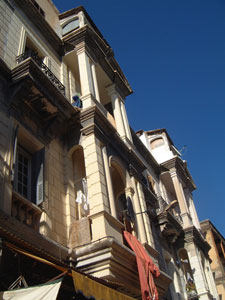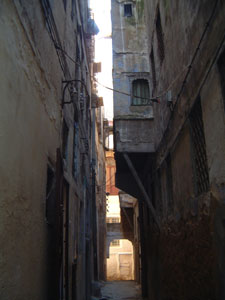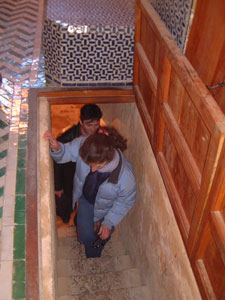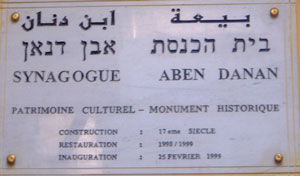 Jewish
Life in Fes
Jewish
Life in Fes
Until
recently Fes was home to the largest and oldest Jewish community in
Morocco. The creation of Israel, the 6 day war and other changes in
the middle eastern political landscape greatly altered dynamics between
Jews and Arabs in Morocco, making it hard to imagine a time when both
communities lived if not 'in harmony', at least in 'peace'. Jews played
a strong economic role in all areas of Morocco, and it is not surprising
to find them at the heart of the Caravan trade, and at the heart of
Fes.
The
Mellah (name given to the Fes Jewish quarter and subsequently to every
Jewish quarter in Morocco) was built in the 14th
century,
as a part of the 'new town' (Fes el Djedid) hosting the administrative
apparatus of the Merinid rule.  Its name derives from the Arabic Al Mellah (salty), as the land it was
built on was of a particularly saline composition. "Mellahs"
, or salty towns, then sprang-up in other parts of the country- with
no relation to any saline grounds! (ah, the ironies of etymology).
Its name derives from the Arabic Al Mellah (salty), as the land it was
built on was of a particularly saline composition. "Mellahs"
, or salty towns, then sprang-up in other parts of the country- with
no relation to any saline grounds! (ah, the ironies of etymology).
Wandering
through the Mellah, one immediately notices the very different architectural
composition of the homes, many of which were built in the 16th century,
when numerous Jewish families fled Andalusia and Christian persecution.
Some
noticeable features are balconies, and elevated external corridors to
enable passage from one house
to another. (see picture)
 Bonnie
(whose Fulbright research focuses on the restoration of buildings in
the Fes medina) led me through the Mellah, pointing to these architectural
oddities (by Moroccan standards). As we stood gazing at the Mellah heights
and wishing we had chosen a better day than Saturday to visit these
quarters (only gentiles would chose the Sabbath to explore Jewish lands!),
a 'fairy godmother' appeared from the depths of a sweat shop, bidding
us to follow him. He was a peculiar fairy godmother: short, hairy and
slightly balding- yet magical nonetheless. We followed him into the
depths of the Mellah, and straight through to one of Fes's 40 or so
Synagogues.
Bonnie
(whose Fulbright research focuses on the restoration of buildings in
the Fes medina) led me through the Mellah, pointing to these architectural
oddities (by Moroccan standards). As we stood gazing at the Mellah heights
and wishing we had chosen a better day than Saturday to visit these
quarters (only gentiles would chose the Sabbath to explore Jewish lands!),
a 'fairy godmother' appeared from the depths of a sweat shop, bidding
us to follow him. He was a peculiar fairy godmother: short, hairy and
slightly balding- yet magical nonetheless. We followed him into the
depths of the Mellah, and straight through to one of Fes's 40 or so
Synagogues.
 Our
self appointed guide claimed to be one of the 500 or so remaining Jews
in Fes. These surviving families put much pride into safeguarding their
heritage, a mission they have been helped in by donors from Europe and
America. The above plaque commemorating the restoration effort of this
now spotless synagogue testifies to this joint effort.
Our
self appointed guide claimed to be one of the 500 or so remaining Jews
in Fes. These surviving families put much pride into safeguarding their
heritage, a mission they have been helped in by donors from Europe and
America. The above plaque commemorating the restoration effort of this
now spotless synagogue testifies to this joint effort.
After this
afternoon in the Mellah, and our earlier experiences with Didier, the
leader of Fes' Jewish community, Bonnie and I started to get a sense
for these
people's pride and heritage- a nostalgia of times past, and a constant
effort to remind visitors that Jews were NEVER mistreated in Morocco
(an assertion that doesn't really hold up to history, yet illustrates
the general mood of the remaining few). As proof of the peaceful cohabitation
between their people and the Moroccan Arabs, Jews always cite the Royal
Financial counselor, who has been Jewish as far back as anyone can recall.
One wonders
at this Diaspora, at the choices people made to stay or go.
One thing is for certain, in Leo's day and age, Jews were singled out
as different, and not often not to their advantage:
| "This
is a rotten place, 25 miles West of Sijilmassa, on the way to the
Draa. It hosts a permanent faction of Arab soldiers who demand tribute
for every Camel that passes by. They ask the same of every Jew that
comes their way. I passed by here one day, traveling with 14 Jews.
The guards asked us to count the number of travelers, and we counted
two less people. The guards did not let us go by and asked that
two stay behind. We had to assure them that two of us were Muslim
and not Jewish. To make sure, they had us recite the Muslim prayer,
then apologized and let us go." (Leo, 431) |